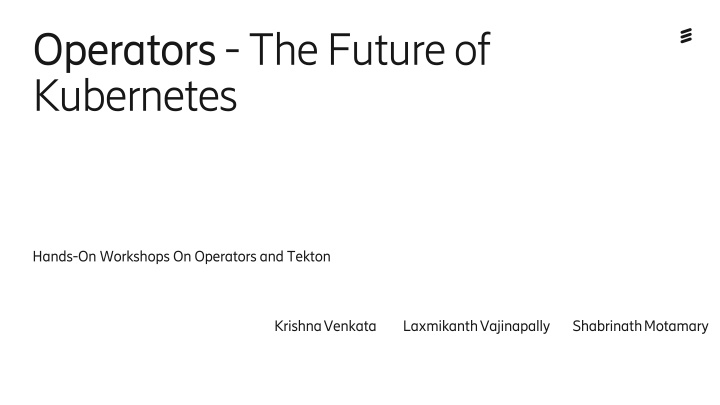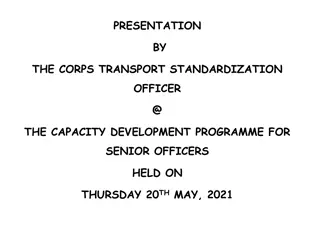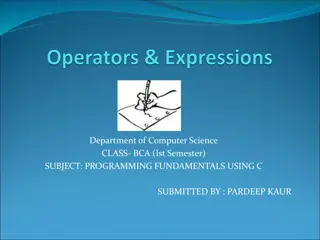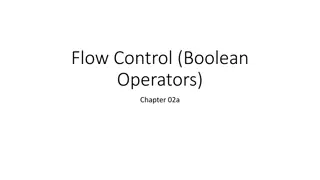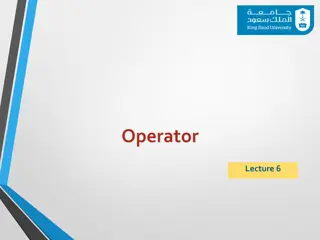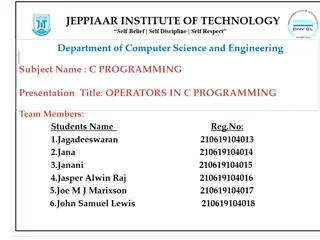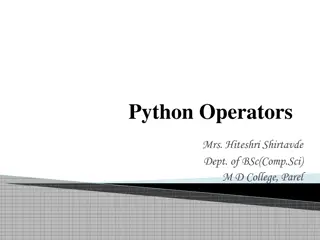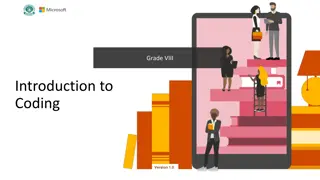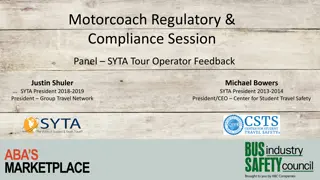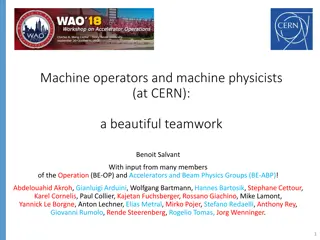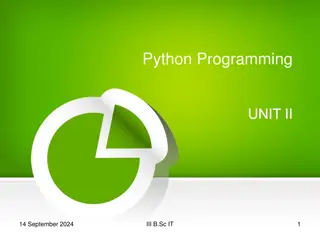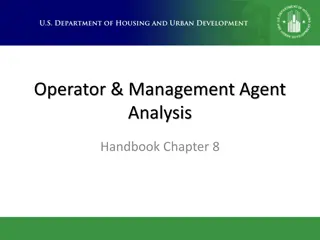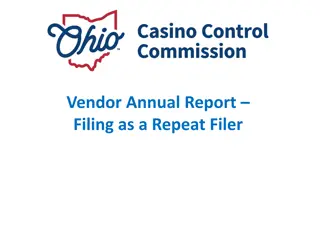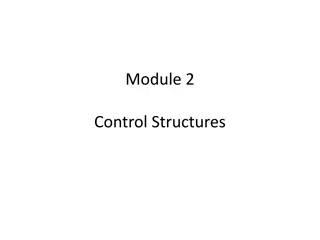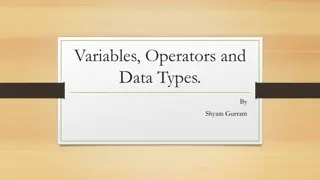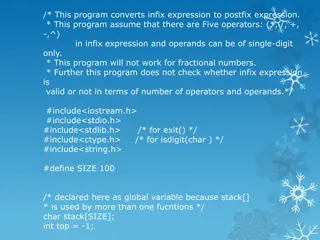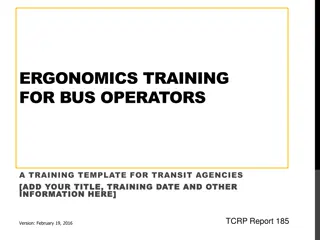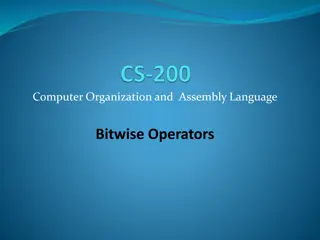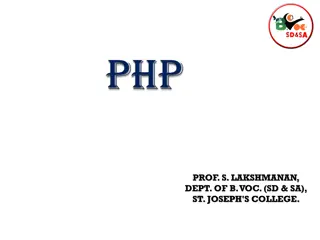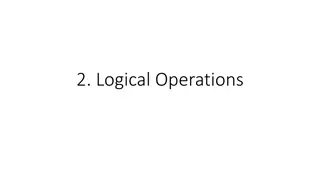Operators and Tekton Workshop Overview
This content provides insights into Operators and Tekton workshops, discussing stateless vs. stateful applications, the role of Operators in Kubernetes, Operator interaction with Kubernetes, and more. Understand the concept of Operators, their types, and their significance in managing Kubernetes applications efficiently.
Uploaded on Feb 22, 2025 | 0 Views
Download Presentation

Please find below an Image/Link to download the presentation.
The content on the website is provided AS IS for your information and personal use only. It may not be sold, licensed, or shared on other websites without obtaining consent from the author.If you encounter any issues during the download, it is possible that the publisher has removed the file from their server.
You are allowed to download the files provided on this website for personal or commercial use, subject to the condition that they are used lawfully. All files are the property of their respective owners.
The content on the website is provided AS IS for your information and personal use only. It may not be sold, licensed, or shared on other websites without obtaining consent from the author.
E N D
Presentation Transcript
Operators-The Future of Kubernetes Hands-On Workshops On Operators and Tekton KrishnaVenkata LaxmikanthVajinapally ShabrinathMotamary Ericsson Internal | 2018-02-21
Agenda Stateless Vs StateFul What is an Operator? Operator Framework Operators Types Best Practices Hands-on Go Based Operator What is Tekton ? Tekton CRDs Hands-On TektonPipeline Ericsson Internal | 2018-02-21
Stateless Vs Stateful Applications Stateless 1. 2. 3. Kubernetes provides powerful in built features to deploy stateless applications e.g. Web Apps Can be destroyed, relocated and upgrade easily. Service Exposes deployments. Stateful 1. 2. 3. 4. 5. Requires domain Knowledge to Deploy, Manage and Scale e.g. Databases. Application specific notions of clustering and interconnectivity. Coordination for authorization and authentication of members. Coordination while scaling in and out. Complex application specific Backup, Healing and life cycle management Ericsson Internal | 2018-02-21
Kubernetes Doesnt and Operators Does This is where Operators Come in, all the cons of Stateful can be achieved by Operators. Operators fill the gap of the application specific things that Kubernetes can t do. Operators extend Kubernetes functionality. Human experience as code. Focus on desired state. Complex, Manual Operational tasks become a single line of Config. Ericsson Internal | 2018-02-21
What is Operator? An Operator is a method of packaging, deploying and managing a Kubernetes application. A Kubernetes application is an application that is both deployed on Kubernetes and managed using the Kubernetes APIs and kubectl tooling. Ericsson Internal | 2018-02-21
Custom Resources Definition Application knowledge Custom Controller Operator Ericsson Internal | 2018-02-21
Application Knowledge Deploy Upgrades Scale Backup Self-Heal/Repair Ericsson Internal | 2018-02-21
Operator Interaction With Kubernetes Operators take advantage of Custom Resource Definition(CRD). CRD s are extensions of the Kubernetes API to register new Resource. Creating a Custom Resource(CR) from CRD s. Operator monitors for new CR request, acknowledges and creates the CR. It Can be used like any other native Kubernetes Resource. Ericsson Internal | 2018-02-21
When to Choose Creating A Operator? Business logic is required. Application uses a declarative API. Automation that watches for updates of Kubernetes object. Create or update resources using Kubernetes API. Ericsson Internal | 2018-02-21
Cluster A has 3 Running Pods Name: summit-etcd-0 Version 2.9.1 Name: summit-etcd-1 Version 2.9.2 Name: summit-etcd-1 Version 2.9.1 Observe Etcd Operator Desired = False Difference in Configuration Version should be 2.9.2 Analyze Cluster Clean, Backup Cluster Upgrade to 2.9.2 Act Ericsson Internal | 2018-02-21
Operator Framework Operator SDK Supports developers in bootstrapping and building an Operator based on their expertise without requiring knowledge of Kubernetes API complexities Operator Lifecycle Manager Helps you to install, update, and generally manage the lifecycle of all of the operators (and their associated services) running across your clusters Operator Metering Metering records historical cluster usage, and can generate usage reports showing usage breakdowns by pod or namespace over arbitrary time periods Ericsson Internal | 2018-02-21
Operator Types Using Operator SDK Operator Type What the SDK generates What you need to define Go Operator Custom objects via CRDs Control loop logic in Go General go program structure Boilerplate code to talk to the Kubernetes API Boilerplate code to watch for Kubernetes objects of interest An entry point to the reconciliation loop Ansible Operator A Go program that runs an Ansible playbook or role every time a certain type of object is detected / modified Custom objects via CRD Helm Operator A Go program that reads a helm chart and deploys all its resources Watch statements to detect changes in the custom objects specification, re-deploying all resources with updated values The location / repository of the helm chart Ericsson Internal | 2018-02-21
Maturity Models of Operators Ericsson Internal | 2018-02-21
Project Layout For Go Based Operator SDK File/Folders File/Folders Purpose Purpose cmd Contains manager/main.go which is the main program of the operator. This instantiates a new manager which registers all custom resource definitions under pkg/apis/... and starts all controllers under pkg/controllers/... . pkg/apis Contains the directory tree that defines the APIs of the Custom Resource Definitions(CRD). Users are expected to edit the pkg/apis/<group>/<version>/<kind>_types.go files to define the API for each resource type and import these packages in their controllers to watch for these resource types. pkg/controller This pkg contains the controller implementations. Users are expected to edit the pkg/controller/<kind>/<kind>_controller.go to define the controller's reconcile logic for handling a resource type of the specified kind. build Contains the Dockerfile and build scripts used to build the operator. deploy Contains various YAML manifests for registering CRDs, setting up RBAC, and deploying the operator as a Deployment. go.mod go.sum The Go mod manifests that describe the external dependencies of this operator. vendor The golang vendor directory that contains local copies of external dependencies that satisfy Go imports in this project. Go modules manages the vendor directory directly. This directory will not exist unless the project is initialized with the --vendor flag, or go mod vendor is run in the project root. Ericsson Internal | 2018-02-21
Watch Ericsson Internal | 2018-02-21
Reconcile Ericsson Internal | 2018-02-21
Operator Best Practices Resource Reconciliation Cycle 1. Instance Validity 2. Instance Initialization 3. Instance Deletion Resource Validation 1. Syntactic validation 2. Semantic validation Validating a resource in the controller Ericsson Internal | 2018-02-21
..continued Resource Initialization Resource Ownership Managing status Ericsson Internal | 2018-02-21
Operatorhub.io Operatorhub.io Ericsson Internal | 2018-02-21
Awesome Operators..!! Rook 1. Rook-Ceph 2. Rook-EdgeFS Kube-Virt Tomcat and Many More Ericsson Internal | 2018-02-21
Operators Hands-on Demo In this demo, we will build a GO-based Operator called Cloner. The project name isopeninfra-summit. kind iskind: Cloner Create a project using theoperator-sdk command line. Add a new CRD API. Updatecloner_types.go as required with custom SpecsandStatus to deploy our applicationCloner. Rungenerate k8sandopenapi to update the generated code for that resource type. Add a new Controller. Register our new CRD with Kubernetes APIServer. Setup RBAC and Deploy our new application called Cloner. Ericsson Internal | 2018-02-21
Operators Hands Operators Hands- -On On Ericsson Internal | 2018-02-21
Operator: Tekton What is Tekton: Tekton itself is an Operator. Tekton is an open source framework to configure and run CI/CD pipelines within a Kubernetes cluster. Tekton is deployed on Kubernetes. Installation: kubectl apply --filename https://storage.googleapis.com/tekton- releases/pipeline/previous/v0.7.0/release.yaml Ericsson Internal | 2018-02-21
Tekton: CRDs Operator= CRDs + Domain specific knowledge + Controller CRDs : Custom Resource Definitions Extending Kubernetes APIs Once installed, Users can create and access its objects using kubectl Controller : Controllers act on Resources to maintains desired state. Ericsson Internal | 2018-02-21
Tekton: CRDs Task Pipeline TaskRun PipelineRun PipelineResource Ericsson Internal | 2018-02-21
Task Task: Contains multiple steps Steps are executed sequentially Every Task is a Pod Takes input and output parameters Step: Smallest Building block of a Task Not a CRD Each step is a container Runs commands within the container Ericsson Internal | 2018-02-21
Pipeline Tasks can be executed in any order using Pipeline Links output and input of Tasks Triggered using PipelineRuns Task Task Task Task Task Ericsson Internal | 2018-02-21
PipelineResource Predefined input/output Used as input and output of Tasks Most common resource types are Git and Image Ericsson Internal | 2018-02-21
PipelineRun and TaskRun PipelineRun and TaskRun are created to trigger Pipeline and Task respectively. PipelineRun creation triggers creation of TaskRuns PipelineRun uses PVC to share resources between Tasks Ericsson Internal | 2018-02-21
Tekton CRDs Overview Task, Pipeline are declared once and re-used. TaskRun, PipelineRun are used to invoke respective Tasks and Pipelines. PipelineResource provides runtime info like Git repo, Image registry to Runs. Pipeline Resource Task PipelineRun Ericsson Internal | 2018-02-21
Tekton: CRDs Tekton resources: Native resources: Pod, Deployment, Service, Ingress etc Task, Pipeline, PipelineRun, TaskRun etc Ericsson Internal | 2018-02-21
Tekton Hands-On Demo This pipeline demonstrates creating an container image from Dockerfile and pushing the newly created image to Dockerhub. Overview of Steps Involved 1. Creating pipeline resources for Git repo and DockerHub 2. Creating Task 3. Creating TaskRun to invoke Task Follow steps from: https://github.com/kvenkata986/shanghai- summit/tree/master/tekton Ericsson Internal | 2018-02-21
Tekton Pipeline Flow PipelineResource TaskRun Task PipelineResource Ericsson Internal | 2018-02-21
1.PipelineResource Ericsson Internal | 2018-02-21
1.PipelineResource 2. Task Ericsson Internal | 2018-02-21
3.TaskRun 1.PipelineResource 2. Task Ericsson Internal | 2018-02-21
Tekton Hands Tekton Hands- -On On Ericsson Internal | 2018-02-21
GitHub: GitHub: https://github.com/kvenkata986/shanghai https://github.com/kvenkata986/shanghai- -summit summit Blog: Blog: https://kvenkata986.github.io https://kvenkata986.github.io Ericsson Internal | 2018-02-21
Questions ? Questions ? Thank You ! Thank You !
